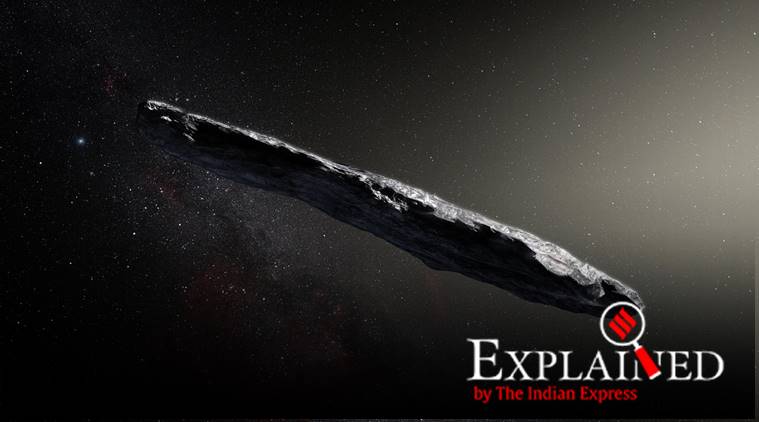Explained: After two in two years, an annual interstellar visit now?
After centuries of never having had a known interstellar visitor, Earth has had two in two years. Astronomers Gregory Laughlin and Malena Rice, however, were not exactly surprised, Yale University said in a statement.
 An artist’s concept of interstellar asteroid 1I/2017 U1 (‘Oumuamua) as it passed through the solar system after its discovery in October 2017. Observations of ‘Oumuamua indicate that it must be very elongated because of its dramatic variations in brightness as it tumbled through space. (Image credit: European Southern Observatory / M. Kornmesser)
An artist’s concept of interstellar asteroid 1I/2017 U1 (‘Oumuamua) as it passed through the solar system after its discovery in October 2017. Observations of ‘Oumuamua indicate that it must be very elongated because of its dramatic variations in brightness as it tumbled through space. (Image credit: European Southern Observatory / M. Kornmesser)
In October 2017, astronomers spotted the first interstellar object known to pass through the Solar System, and named it ‘Oumuamua’. It gave rise to initial speculation that it was an alien spaceship, but scientists have since concluded that ‘Oumuamua likely has properties similar to a comet.
This summer came a new object, dubbed 2I/Borisov. Researchers will have about a year to observe the object with telescopes.
After centuries of never having had a known interstellar visitor, Earth has had two in two years. Astronomers Gregory Laughlin and Malena Rice, however, were not exactly surprised, Yale University said in a statement.
The astronomers have just completed a study that suggests these strange visitors are going to keep coming. A few large objects can be expected to show up every year, they say, and smaller objects entering the Solar System could reach into the hundreds each year. The study has been accepted for publication in The Astrophysical Journal Letters, Yale said.
“There should be a lot of this material floating around. So much more data will be coming out soon, thanks to new telescopes coming online. We won’t have to speculate,” Rice, the first author, said in the statement.
The research proposes that interstellar objects could be material ejected from large, newborn planets, orbiting farther away from their suns. They suggest that these have carved out pronounced gaps in the protoplanetary disks — cosmic platters of gas and dust.
To test their theory, Rice and Laughlin looked at three protoplanetary disks from the Disk Substructures at High Angular Resolution Project (DSHARP), a survey conducted by a consortium of astronomers. DSHARP focuses on images of 20 nearby, bright and large protoplanetary disks.
“We were looking for disks in which it was pretty clear a planet was there. If a disk has clear gaps in it, like several of the DSHARP disks do, it’s possible to extrapolate what type of planet would be there. Then, we can simulate the systems to see how much material should be ejected over time,” Rice said.
“This idea nicely explains the high density of these objects drifting in interstellar space, and it shows that we should be finding up to hundreds of these objects with upcoming surveys coming online next year,” Laughlin said.
- 01
- 02
- 03
- 04
- 05






































